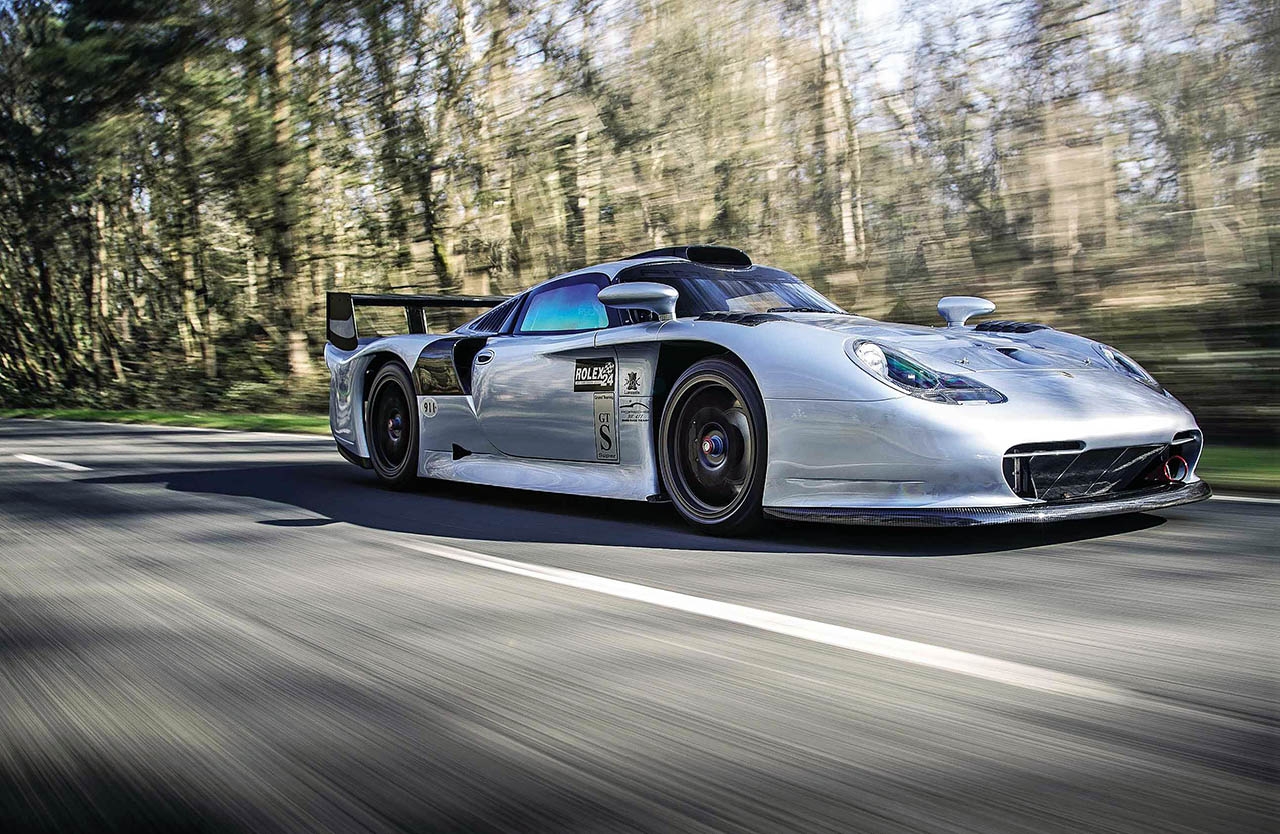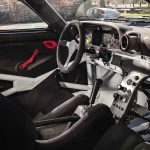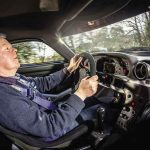
Porsche 911 GT1 On the road in a car built for endurance racing. It’s a road car. Honest. It’s got more in common with a Group C 962 than a plain old 911, and it competed at Daytona. Yet this Porsche GT1 is just perfect for a trip to the pub… Words John Simister. Photography Charlie Magee.
Why am I here? I’m in the wrong car in the wrong place at the wrong time. I’m in an automotive parallel universe superimposed on the real one, and I hope the natives don’t turn hostile on the alien invader from another dimension. After all, we all have to share the same piece of A3.

In my universe, travelling over 200mph is normal behaviour and why would you want to see through a rear window? So I don’t have one; the space is full of carbonfibre air-duct. So I can’t readily see the clouds of partly burnt hydrocarbons that accompany every foray into maximum boost and the dissolving of a horizon. For all that, though, I am driving a car whose identity is grounded in the real universe. It’s a Porsche 911. Can’t you tell? You would think, then, that the long tail houses a flat-six behind the rear wheels, making this 1997-built car a more modern reinterpretation of the various 935s that dominated endurance racing in the mid-1970s. But it doesn’t. Within that rear overhang are just an enormous gearbox and a pair of long exhaust pipes silenced only by turbochargers, plus the framework to support the tail and the downforce generated by the rear wing. The engine, instead, is just behind the cockpit, making this the only 911 with a midmounted engine. So is it really a 911 at all? Hmm… discuss.
It is, however, a racing car, one with a string of wins in the Canadian GT1 championship. And it is now road legal in the UK, or was on the day it got its registration number. It’s a Porsche 911 GT1, the type that was Weissach’s answer to the McLaren F1 GTR and a Le Mans class-winner (and second overall) first time out. Forty-six examples were made, 20 of them race versions and the rest road versions required for homologation, and thence eligibility for the FIA GT Championship. Our car here, though, is not a Strassenversion; it is, or was, one of the 20 real racers.
The idea of the FIA GT Championship was to bring back a worldwide series of endurance races for ‘sports’ cars, something that fizzled out when the World Sportscar Championship – Le Mans, Daytona and the rest – ceased at the end of 1992. It had long been a series for sports prototypes, although more production-based cars could also compete. The new GT Championship was intended to be for racing cars derived from road versions, and had started out in 1994 as the BPR Global GT Series before becoming an official FIA series from 1996. The GT1 class was for the most-modified cars; GT2 was closer to standard. To compete in GT1, 25 road versions had to be made. But how do you define ‘derived from’? Where, temporally, do you place the chicken and the egg? If there is the letter of the rules, is there also the spirit? A McLaren F1 GTR obviously arose from a regular F1. Ditto a racing Ferrari F40 or Jaguar XJ220. But a 911 GT1 from the 993, or 996, at your local Porsche Centre? Nein.
It was the numbers that made it eligible, along with Porsche’s resources that enabled the company to replicate what were practically old-school prototypes, just as it had done a quarter of a century earlier with the 917. There are 911 bits here and there in the GT1, though, not least for marketing reasons so the public might identify it with a 911 road car. There is, for example, the front half of a 993 floorpan. The dashboard is shaped roughly like a 993’s and has a few of its round switches.
Then it gets fuzzier. The contemporary roadgoing 911 was the 996 generation, so the GT1 has 996 headlight lenses, tail-lights and door handles. It also, like the 996, has water-cooling, but this is because the engine – indeed, pretty much the whole car aft of the cabin – is developed from that of the Group C 962, twin turbochargers and all. There are 962-like double wishbones at the front, too, though the spring/damper units are anchored at their upper ends in the original 993 strut towers.
We’re in the surgically clean workshop of Lanzante, restorer and race-car preparer to the automotive gentry, when I see the 911 GT1 for the first time. It’s silver, as it always was, but now the various scripts and sponsor logos are picked out in black instead of the original multiple colours. Nor are there any race numbers, or spaces devoted to their positioning. It’s all to suit the subtlety (relatively speaking) of the GT1’s new roadgoing role. JustafewdetailsmarkthisasarepurposedracerratherthanaStrassenversion.
The latter lacks P1 POW’s air-exit vents above the front wheelarches, the NACA ducts towards the rear of the sills, the visible carbonfibre that forms the air scoops aft of the doors. The racer’s rear wing is bigger and squarer, the headlight units lack the internal finishers, and there are neither side marker lights nor neat finishers for the wheel centres. There’s no prettying-up here. Am I feeling any 911 connection yet? Not really; it’s a label, nothing more, just as the slightly later Mercedes-Benz CLK GTR bore scant visual or conceptual resemblance to a regular CLK, Mercedes having copied Porsche’s trick. Both Merc and Porsche, incidentally, proved early on to have a distressing tendency to perform aerobatic loops at racing speeds.
Were I to force my brain to identify a 911 in the vision before me, it would clutch at the nose styling (air orifices notwithstanding), and the shape, if not the compression, of the windscreen and the side-window apertures, ignoring the fact that the rear side ‘windows’ are actually carbonfibre louvres. From the back the GT1 looks like a 911 hiding in its own garage. But it’s all hurting my brain too much. Better to think of what this car is than what it pretends to be. The sonic eruption from its aft end helps here, a rending of air in among which can just be made out the familiar harmonics of a Porsche flat-six. It has been warmed up earlier, so is now ready for owner Chris Wilson to drive to the pub. This was not in the GT1’s original design brief, but why not? Being able to relish such incongruity is one reason why Chris bought it. He’s a serial 911 nut and, indeed, 911 racer, and when the ultimate version presented itself he was powerless to resist.
It’s gone, and I didn’t see which way it went. A quick bit of navigation later and we’re back with the Porsche in the car park of the Deers Hut, where it is attracting quite a lot of interest from people standing behind their mobile phones. We have a pub lunch, of course, ethanol-free just like the fuel in the GT1’s tank. Chris had to be careful where he parked, and he had to choose his route carefully, because speedbumps scrape the low nose and the turning circle is broader than that of a bus.
And now it’s me, about to drive out of a pub car park in a car that raced in the 2001 Daytona 24 Hours (it qualified 12th but finished 41st after a gearbox change). Tyres apart, it’s mechanically just as it was back then, albeit running on the gentlest of its various engine maps, but there’s still well over 600bhp on tap. It’s a sunny day so racing slicks might have made the GT1 experience yet more authentic, though maybe not on the A3. Instead the Porsche is running on Michelin Pilot Sports, which just happen to be the same size as a McLaren F1’s, and which are obtainable only through McLaren. So Lanzante’s relationship with McLaren ironically helps with the road-running of McLaren’s past deadly rival.
The same goes for the Porsche’s TAG engine management, the deepest knowledge of which still resides in Woking. Strassenversion GT1s use Motec management with pansified refinements such as a cold-start map and the ability to optimise mixtures for catalytic conversion and driving in slow traffic. Here, though, the fuel is just squirted in and set on fire as though every drive is a max-attack race.
Right. Thread self into race-functional cabin dotted with alien switches, tie self into racing seat with six harness straps. Twist key, wait for the fuel pump to stop whirring, signifying sufficient fuel pressure. Simultaneously, the dim LCD instrument display comes to life. How will I read that, driving into the sun? Twist key further until the engine catches and my eardrums rattle around my head. ‘Be firm with the gearbox,’ Chris shouts, ‘or it will crunch.’ It’s effectively a racing dog-box with merely token synchromesh (typical of a high-end Porsche racer), although it’s non-sequential and has a regular shift pattern at the front end of its exposed linkage.
Ker-lunk. We’re in first. Clutch heavy but more progressive than I feared. Whirring, whining motion is achieved as I aim out of the car park onto the road that will lead to the A3-ring, as my inner fantasist is trying not to call it. Second, third, changing up early. Then an exploratory prod of the accelerator pedal’s further reaches, just 2500rpm flashing on the tacho display. The engine breathes in and exhales with a mighty blow, we rocket forwards with a lack of lag extraordinary given the two turbochargers’ ample size. A racecar with real low-end torque. What will happen if I do the same thing at, say, 5000rpm?
Approaching the roundabout I attempt a gentle rev-matching throttle-blip during the downshift, hoping for the silken ratio-change that makes a manual car so satisfying. Such finesse is pointless. The GT1 thinks me indecisive and rewards me with a loud crunch as gears fail to mesh. Yes. Be firm. It’s a racing car, a modern-ish racing car too young to respond to road-car niceties. They only slow things down. OK, so I happen to be on the road. And?
Now we’re on the road that isn’t a racetrack but the GT1 doesn’t care. I hear a sound from Chris but I can’t make it out. We happen to be doing about 5000rpm, I can’t read the flickering speed figures and Chris’s body movements are exhorting me to put my foot down, hard. I really hope there are no blue lights nearby, ready to flash, not that I’d see them other than in the door-mirrors and my peripheral vision.
So I do. Expletive. Another one. Then I change up a gear, well before the 8500rpm limit, to the swish and chirrup of the wastegates and the bangs and pops from those giant exhausts as slugs of unburnt fuel combust. Foot down again, and then I take fright as I sense I’m using up my luck very quickly.
Chris is laughing out loud. Or, at least, I think he is. Speed is still gathering as we move along the slip-road. Were this the lead-in to Daytona’s banking I would be feeling lots of downforce, but I can’t report on aero in an A3 context. The GT1 does steer nicely, though, its power-assistance not overwhelming but no doubt very necessary when the tyres are being squashed. And now we’re heading to Liphook, sweeping extra-widely round inconvenient corners and straightlining otherwise impossible miniroundabouts, then out on the old A3 (now B2070, still with some dualcarriageway sections) and into sleepy Liss. Sleepy no more, this afternoon.
This is a car entirely unsuited to the road, of course, which makes using it there simultaneously amusing and pointless. You can never get anywhere near even the meat of its abilities, never mind the limits, but then the same applies to most modern supercars. However, owners of those might want you to take their cars seriously. No such ego-trip troubles Chris and his GT1. The absurdity is what he loves about it.
He bought it three years ago, a decade after first owner, Canada-based racing driver Klaus Bytzek, raced it for the last time at Mosport Park. Bytzek had in 1999 taken delivery of this car, the only GT1 to be built from scratch by Porsche in Evo trim, the other Evo-spec GT1s having been converted from earlier examples, and he won the Canadian championship with it in 1999, 2000 and 2001. He won in 2002, too, but used another GT1 for one race.
Then he did that final 2003 race, after which GT1.117 was laid up exactly as it had finished the race.
It needed a complete nut-and-bolt rebuild by the time Chris got it to the UK, which Lanzante duly performed prior to its appearance at the 2015 Goodwood Festival of Speed. Suiting it for street rather than circuit included replacing the carbon-ceramic brake discs with steel ones (as also used at Daytona), fitting a lower-temperature radiator thermostat, adding a 993-sourced handbrake system and building a secondary wiring loom for indicators, horn and other roadgoing necessities.
One necessity it already had is a low-fuel warning light, vital in an endurance race. During my drive, it flashes. ‘But we filled it up this morning,’ Chris frets, ‘and it can’t have run out yet.’
A telephone call to the GT1’s master mechanic confirms that we probably still have enough fuel. Then, as Chris drives his Porsche from Liss to Lanzante, it coughs to a halt. No fuel; it currently has a small, sprint-race tank and we’ve spread a sprint-race’s-worth of combusted hydrocarbons over Hampshire. The warning light was right after all. ‘Of course it was,’ says Chris. ‘It’s a Porsche. So everything works.’
Thanks To Lanzante, www.lanzante.co.uk. The GT1 will be offered at the RM Sotheby’s auction in Monte Carlo on 14 May, www.rmsothebys.com.
‘WERE THIS DAYTONA’S BANKING I WOULD BE FEELING LOTS OF DOWNFORCE, BUT I CAN’T REPORT ON AERO ON THE A3’
Left and below Digital instruments offer information on revs and road speed, which may be fine on the track at Daytona but are difficult to read on the road in Surrey; twin-turbo flat-six was developed for endurance racing, pumps out 640bhp – and is (whisper it) mid-mounted.
TECHNICAL DATA 1997 Porsche 911 GT1
Engine 3164cc flat-six, water-cooled, dry-sumped, DOHC per bank, 24 valves, TAG 3.8 engine management, two KKK K27 turbochargers
Power 640bhp @ 7200rpm
Torque 479lb ft @ 5500rpm
Transmission Five-speed manual, rear-wheel drive
Steering Rack and pinion, power-assisted
Suspension Front: double wishbones, coil spring/damper units, anti-roll bar. Rear: double wishbones, horizontal spring/damper units operated by pushrods and bellcranks, anti-roll bar
Brakes Vented and grooved discs
Weight 1000kg (approx)
Performance Top speed over 200mph. 0-60mph 3.5sec (approximately, on long gearing, though sprint gearing is fitted to this car)
‘I CHANGE UP A GEAR TO THE SWISH AND CHIRRUP OF WASTEGATES AND THE BANGS AND POPS FROM THOSE GIANT EXHAUSTS’
Above and left. The GT1’s body is a mish-mash of 911 visual cues, as it was conceived in the 993 era (check the dashboard) and sold in the 996 era (headlamps, tail-lights, doorhandles). Floorpan is a mix of 993 and Group C 962 – which also donates the powertrain.


















